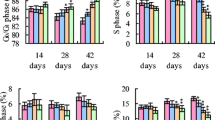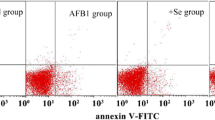Abstract
The experiment was conducted with the objective of examining the effects of high molybdenum on the cell cycle and apoptosis of kidney in broilers by the methods of flow cytometry. Three hundred 1-day-old Avian broilers were randomly divided into four groups, and fed on diets as follows: control diet (Mo 13 mg/kg) and high molybdenum diets (Mo 500 mg/kg, high molybdenum group I; Mo 1,000 mg/kg, high molybdenum group II; Mo 1,500 mg/kg, high molybdenum group III) for 6 weeks. The results showed that the relative weight of kidney were higher (P < 0.05 or P < 0.01), and the cellular percentages of G0/G1 phase were lower, and cellular percentages of S phase and the proliferating index were higher in high molybdenum groups II and III than in control group (P < 0.01). The percentage of renal cell apoptosis was increased in high molybdenum groups II and III when compared with that of control group (P < 0.01). Immunohistochemical test showed that there were increased frequencies of positive cells containing Bax protein and decreased frequencies of positive cells containing Bcl-2 protein in high molybdenum groups II and III. It was concluded that dietary high molybdenum (1,000 mg/kg and 1,500 mg/kg) impaired the progression of renal cells from S phase to G2M phase obviously and induced renal cell apoptosis.




Similar content being viewed by others
Abbreviations
- PI:
-
Propidium iodide
- PI value:
-
Proliferation index value
References
Anders I, Seldén N, Berg P et al (2005) Occupational molybdenum exposure and a gouty electrician. Occup Med 55:145–148
Anke MK (2004) Molybdenum. In: Merian E, Anke M, Ihnat M, Stoeppler M (eds) Elements and their compounds in the environment. Wiley, Weinheim, pp 1007–1037
Novotny JA, Turnlund JR (2007) Molybdenum intake influences molybdenum kinetics in men. J Nutr 137:37–42
Vyskocil A, Viau C (1999) Assessment of molybdenum toxicity in humans. J Appl Toxicol 19:185–192
Fan Yang, Hengmin Cui, Jie Xiao et al. (2010) Increased apoptotic lymphocyte population in the spleen of young chickens fed diets high in molybdenum. Biol Trace Elem Res. doi:10.1007/s12011-010-8697-y.
Mariko mochizuki, rei sasaki, yuko yamashita et al (2002) The distribution of molybdenum in the tissues of wild ducks. Environ Monit Assess 77:155–161
Chen T, Cui Y, Bai C et al (2009) Increased apoptotic lymphocyte population of spleen in chickens fed on diets excess in fluorine. Fluoride 42(2):134–140
Peng X, Cui Y, Cui W et al (2009) The decrease of relative weight, lesions, and apoptosis of bursa of Fabricius induced by excess dietary selenium in chickens. Biol Trace Elem Res 131(1):33–42
Wang JM, Xiao BL, Zheng JW et al (2007) Effect of targeted magnetic nanoparticles containing 5-FU on expression of bcl-2, bax and caspase 3 in nude mice with transplanted human liver cancer. World J Gastroenterol 13(23):3171–3175
Caimin Bai, Tao Chen, Yun Cui et al. (2010) Effect of high fluorine on the cell cycle and apoptosis of renal cells in chickens. Bio Trace Elem Res. doi:10.1007/s12011-009-8599-z.
Bertrand J, Liagre B, Bégaud-Grimaud G et al (2009) Analysis of relationship between cell cycle stage and apoptosis induction in K562 cells by sedimentation field-flow fractionation. J Chromatogr B 877:1155–1161
Zhang M, Wang A, Tao X et al (2008) Effect of fluoride on DNA damage, S-phase cell-cycle arrest and the expression of NF-κB in primary cultured rat hippocampal neurons. Toxi Let 179:1–5
Haschek WM, Rousseaux CC, Wallig MA (2002) Handbook of toxicologic pathology, 2nd edn. Academic Press, San Francisco, New York, pp 595–625
Lee YM, Ting CM, Cheng YK et al (2008) Mechanisms of 2-methoxyestradiol-induced apoptosis and G2/M cell cycle arrest of nasophageal carcinoma cells. Cancer Lett 268:295–307
Ouyang G, Yao L, Ruan K et al (2009) Genistein induces G2/M cell cycle arrest and apoptosis of human ovariancancer cells via activation of DNA damage checkpoint pathways. Cell Biol Int 33:1237–1244
Smiraglia DJ, Smith LT, Lang JC et al (2003) Differential targets of CpG island hypermethylation in primary and metastatic head and neck squamous cell carcinoma(HNSCC). J Med Genet 40(1):25–33
Barreto Filho JB, Marques Junior AP (1993) Aspectos histológicos da placenta de vacas Zebu. Arq Bras Med Vet Zootec 45:385–393
Raisbeck MF, Siemion RS, Smith MA (2006) Modest copper supplementation blocks molybdenosis in cattle. J Vet Diagn Invest 18:566–572
Zamzami N, Marchetti P, Castedo M (1995) Reduction in mitochondrial potential constitutes an early irreversible step of programmed lymphocyte death in vivo. J Exp Med 181:161
Je-Ken Chang, Ching-Ju Li, Hsiu-Jun Liao et al (2009) Anti-inflammatory drugs suppress proliferation and induce apoptosis through altering expressions of cell cycle regulators and pro-apoptotic factors in cultured human osteoblasts. Toxicology 258:148–156
Oltvai ZN, Milliman CL, Korsmeyer SJ (1993) Bcl-2 heterodimerizes in vivo with a conservedhomolog, Bax, that accelerates programmed cell death. Cell 74(4):609–619
Roset R, Ortet L, Gil G et al (2007) Role of Bcl-2 family members onapoptosis: what we have learned from knock-out mice. Front Biosci 12(20):4722–4730
Acknowledgment
The study was supported by Program for Changjiang Scholars and Innovative Research Team in University (IRT 0848) and Key Program of Education Department and Scientific Department of Sichuan Province (09ZZ017).
Author information
Authors and Affiliations
Corresponding author
Rights and permissions
About this article
Cite this article
Xiao, J., Cui, Hm., Yang, F. et al. Effect of Dietary High Molybdenum on the Cell Cycle and Apoptosis of Kidney in Broilers. Biol Trace Elem Res 142, 523–531 (2011). https://doi.org/10.1007/s12011-010-8772-4
Received:
Accepted:
Published:
Issue Date:
DOI: https://doi.org/10.1007/s12011-010-8772-4




